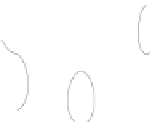Information Technology Reference
In-Depth Information
(a)
(b)
Fig. 2.6
Useful visualizations for placing kernels. These provide insight into how the kernels
interact with an image: (a) the sum of the kernels; and (b) the kernels overlayed on the image
at the goal location
This represents an error of 2-5 encoder counts for each of the joint variables of the
robot. While the maximum error was 1.5 orders of magnitude larger, there were
many trials that were near this minimum error.
Figure 2.8 shows the camera trajectories of the robot along the optical axis for
the 50 experimental trials of depth motion. The corresponding error statistics are
shown in Table 2.2.
Figure 2.9 shows the rotations about the focus of the parabolic mirror for the
50 experimental trials of rigid body rotations. The error statistics for the angles
are found in Table 2.3. The determination of the domain of attraction for the rigid
body rotations indicated that the maximum allowable move would be approximately
±
5
◦
in each of the angles. However, experimentation showed that the system rarely
failed for initial displacements of approximately
9
◦
. Upon closer inspection of
Figure 2.5, it is evident that there is a region of the volume near the 5
◦
radius and
the 9
◦
radius where
V
is positive. Figure 2.9 shows one failed trial whose initial
±






Search WWH ::

Custom Search